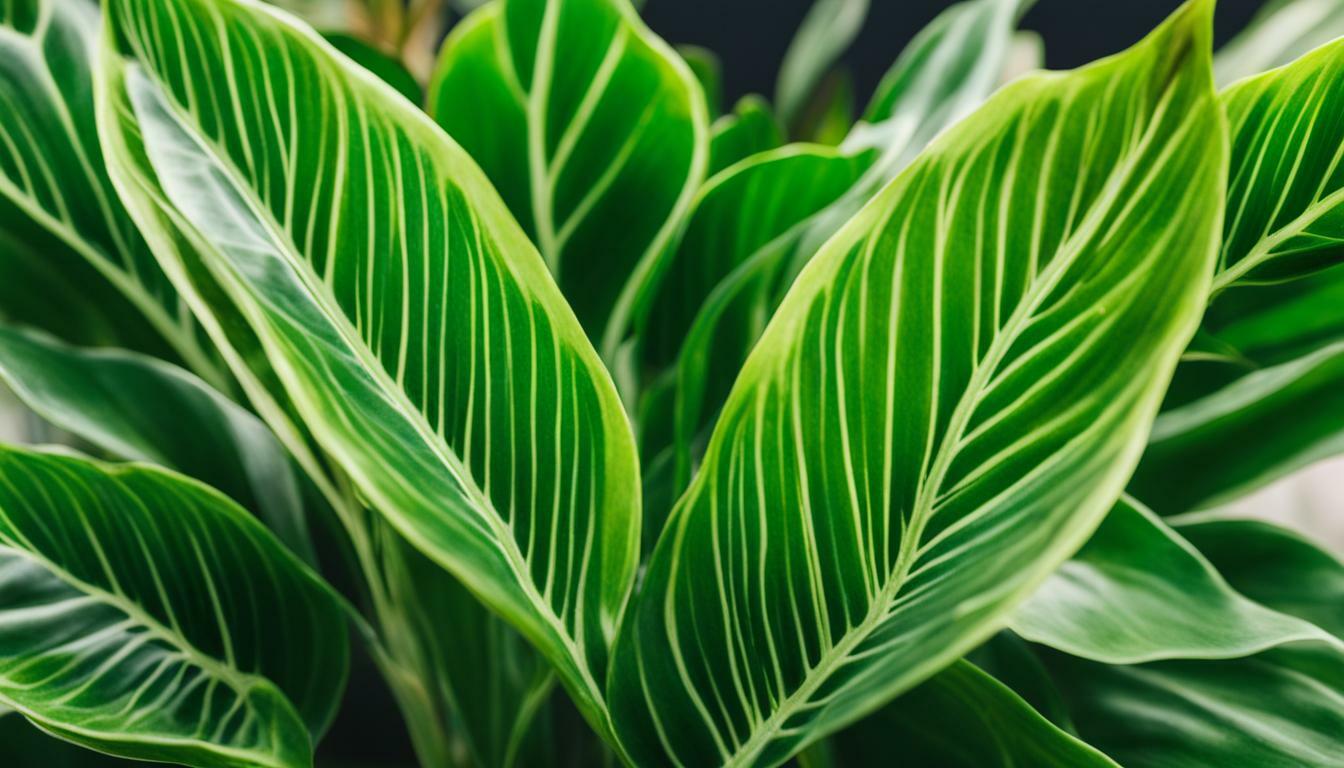Welcome to our comprehensive guide on how to grow and care for Terrarium Plants ZZ plants. Whether you’re a beginner or an experienced indoor gardener, these low-maintenance plants are perfect for creating a green sanctuary in your home.
Factual data: ZZ plants, also known as Zamioculcas zamiifolia, are low-maintenance houseplants that are perfect for beginners or those with a black thumb. They are native to Eastern Africa and can tolerate low light and drought conditions. ZZ plants have glossy, oval-shaped, dark green leaves and grow from bulbous rhizomes that store water.
To care for ZZ plants, they should be planted in well-drained soil and placed in an area with natural or fluorescent light. They can tolerate low humidity and irregular watering. Overwatering can cause the leaves to turn yellow, indicating root rot. ZZ plants can be fertilized with a regular houseplant fertilizer a few times a year.
There are different varieties of ZZ plants, including the Raven ZZ plant with dark purple foliage and the dwarf variety called Zamicro. ZZ plants can be propagated by division or stem cuttings.
ZZ plants are known for their air-purifying qualities, as they can remove toxins from the air. However, it’s important to note that all parts of the plant are toxic, so they should be kept out of reach of children and pets.
Overall, ZZ plants are easy to care for and can thrive in a variety of conditions, making them a great addition to any terrarium or indoor garden.
Key Takeaways:
- ZZ plants are low-maintenance houseplants that can tolerate low light and drought conditions.
- They have glossy, oval-shaped, dark green leaves and grow from bulbous rhizomes.
- To care for ZZ plants, use well-drained soil, provide suitable lighting, and avoid overwatering.
- There are different varieties of ZZ plants, including the Raven ZZ plant and the dwarf Zamicro.
- ZZ plants are air-purifying but toxic, so they should be kept out of reach of children and pets.
About ZZ Plants
ZZ plants, also known as Zamioculcas zamiifolia, are popular indoor plants that can thrive in a variety of conditions. Native to Eastern Africa, these houseplants have glossy, oval-shaped, dark green leaves and grow from bulbous rhizomes that store water. Their unique leaf structure and ability to tolerate low light and drought conditions make them a great choice for those looking for low-maintenance indoor plants.
When it comes to caring for ZZ plants, they are relatively easy to maintain. They can be planted in well-drained soil and placed in an area with natural or fluorescent light. These plants can tolerate low humidity and irregular watering, making them ideal for those who may forget to water their plants regularly. However, it’s important to avoid overwatering, as this can lead to root rot and yellowing of the leaves.
ZZ plants can be fertilized with a regular houseplant fertilizer a few times a year to promote healthy growth. There are also different varieties of ZZ plants available, including the popular Raven ZZ plant with its dark purple foliage and the Zamicro dwarf variety. These plants can be propagated through division or stem cuttings, making it easy to expand your collection.
While ZZ plants are known for their air-purifying qualities, it’s important to note that all parts of the plant are toxic. Therefore, they should be kept out of reach of children and pets. Despite this, ZZ plants remain a popular choice for indoor gardening enthusiasts due to their unique appearance and low maintenance requirements.
ZZ Plants Quick Facts:
- Scientific name: Zamioculcas zamiifolia
- Origin: Eastern Africa
- Leaf structure: Glossy, oval-shaped, dark green leaves
- Growth habit: Bulbous rhizomes that store water
- Care requirements: Well-drained soil, low light tolerance, irregular watering
- Varieties: Raven ZZ plant (with dark purple foliage), Zamicro (dwarf variety)
- Propagation methods: Division, stem cuttings
- Air-purifying qualities: ZZ plants can remove toxins from the air
- Safety considerations: All parts of the plant are toxic
| Scientific name | Origin | Leaf structure | Growth habit |
|---|---|---|---|
| Zamioculcas zamiifolia | Eastern Africa | Glossy, oval-shaped, dark green leaves | Bulbous rhizomes that store water |
ZZ plants are a fantastic choice for indoor gardeners, thanks to their ability to thrive in a variety of conditions. Whether you’re a beginner or an experienced plant parent, ZZ plants offer a beautiful and low-maintenance addition to your indoor space.
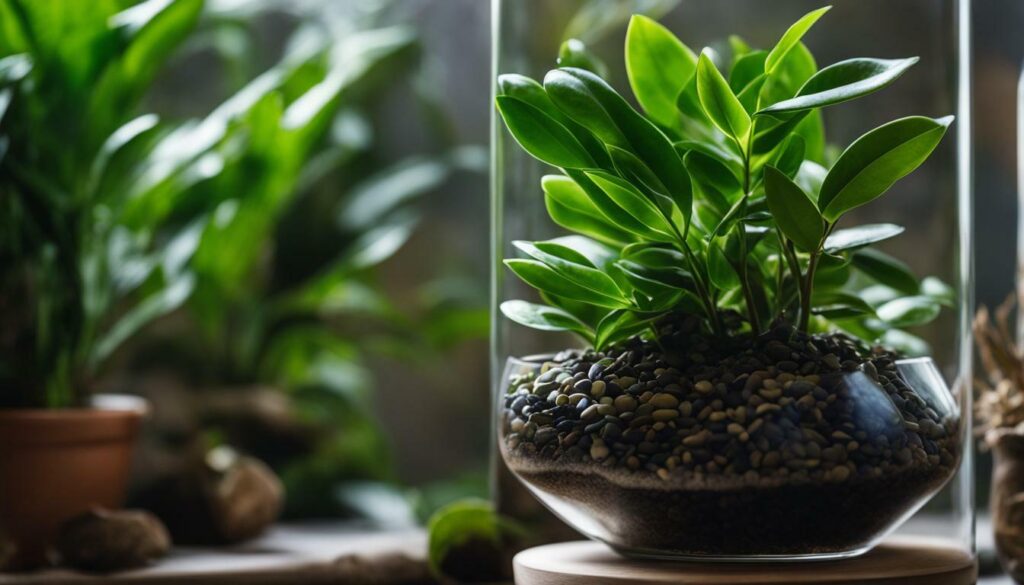
When it comes to creating the perfect environment for your ZZ plants in a terrarium, there are a few key factors to consider. From the type of soil to the lighting requirements, we’ll guide you through the process of setting up your terrarium.
Soil
ZZ plants prefer well-drained soil to prevent waterlogged roots. A mix of regular potting soil and perlite or sand works well to ensure proper drainage. Avoid using heavy or compacted soils that retain too much moisture.
Lighting
ZZ plants can tolerate low light conditions, but they will grow best with moderate to bright indirect light. Place your terrarium in an area with natural or fluorescent light for optimal growth. If using artificial light, aim for 12-16 hours of light per day.
Container
Choose a terrarium container that provides enough space for your ZZ plant to grow. It should have proper drainage holes to prevent water buildup. Consider the size and shape of your terrarium, as well as the overall design and aesthetics when selecting a container.
Decorative Elements
Enhance the visual appeal of your terrarium by adding decorative elements. You can include small figurines, rocks, or moss to create a natural and inviting environment for your ZZ plants. Be sure to choose non-toxic materials that won’t harm your plants.
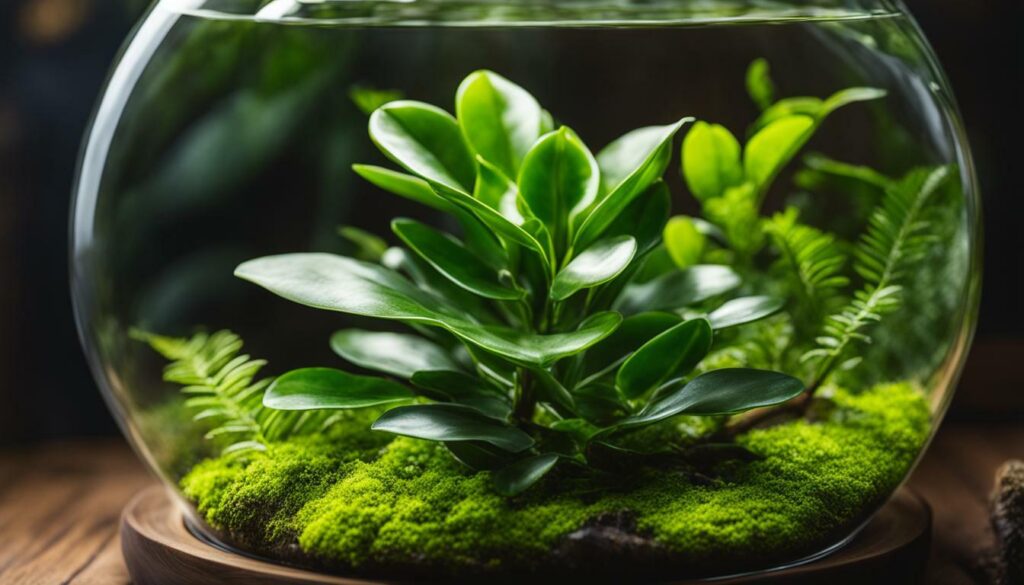
| Summary of Terrarium Setup for ZZ Plants: |
|---|
| Use well-drained soil, such as a mix of potting soil and perlite or sand. |
| Provide moderate to bright indirect light, natural or fluorescent, for 12-16 hours a day. |
| Select a terrarium container with proper drainage holes that suits the size and design you prefer. |
| Add decorative elements like figurines, rocks, or moss to enhance the visual appeal. |
By following these guidelines, you can create an ideal terrarium setup for your ZZ plants. Remember to monitor the moisture levels and adjust watering accordingly to prevent overwatering. With the right conditions, your ZZ plants will thrive and bring beauty to your indoor garden.
Proper Watering and Humidity Levels
Finding the right balance of water and humidity is crucial for the health and vitality of your ZZ plants in a terrarium. In this section, we’ll share tips and techniques to ensure your plants receive adequate hydration and thrive in a controlled environment.
To water ZZ plants in a terrarium, it’s important to avoid overwatering, as this can lead to root rot. ZZ plants are well-suited to low water conditions and prefer to dry out between waterings. It’s best to wait until the top inch of soil is dry before watering again. This will help prevent waterlogged soil and keep your plants healthy.
In addition to proper watering, maintaining the right humidity levels is essential for ZZ plants in a terrarium. These plants can tolerate low humidity but thrive in higher humidity environments. You can increase humidity by misting the leaves with water or placing a tray of water near the plants, allowing for evaporation.
Remember, it’s important to monitor your plants closely and adjust your watering and humidity routine accordingly. Factors such as the size of your terrarium, temperature, and air circulation can affect how often you need to water and adjust humidity levels for your ZZ plants.
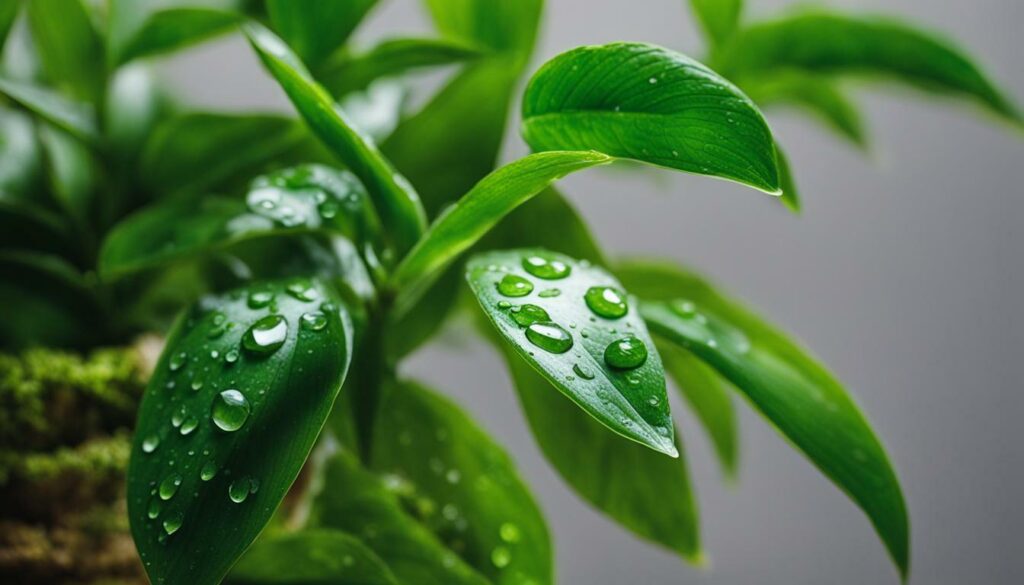
| Watering Tips | Humidity Tips |
|---|---|
|
|
Fertilizing ZZ Plants
To enhance the growth and vitality of your ZZ plants in a terrarium, proper fertilization is essential. In this section, we’ll cover everything you need to know about fertilizing these plants and keeping them thriving in an indoor greenery environment.
ZZ plants are known for their ability to thrive in low light and drought conditions, making them low-maintenance options for indoor gardens. However, they still require some nutrients to support their growth. Fertilizing ZZ plants can help provide them with the necessary vitamins and minerals they need to stay healthy and vibrant.
When it comes to fertilizing ZZ plants, it’s important to choose a balanced houseplant fertilizer. Look for a formulation with equal proportions of nitrogen (N), phosphorus (P), and potassium (K) to ensure you’re providing a well-rounded diet for your plants. Apply the fertilizer according to the instructions on the package, usually every two to three months during the growing season.
While ZZ plants can tolerate irregular watering, it’s important to note that fertilizing should be done when the soil is already slightly moist. This helps prevent any potential burning of the plant’s roots. Additionally, avoid overfertilizing, as this can lead to salt buildup in the soil and cause damage to the plant. Always follow the recommended dosage and frequency for the specific fertilizer you choose.
Fertilizing ZZ Plants: Quick Tips
- Choose a balanced houseplant fertilizer with equal proportions of nitrogen, phosphorus, and potassium.
- Apply the fertilizer when the soil is slightly moist to avoid root burn.
- Follow the recommended dosage and frequency specified on the fertilizer package.
- Avoid overfertilizing to prevent salt buildup and damage to the plant.
By following these fertilization tips and guidelines, you can ensure that your ZZ plants receive the nutrients they need to thrive and remain healthy in your indoor greenery setup. Remember to always monitor the condition of your plants and adjust the fertilization routine as necessary. Happy gardening!
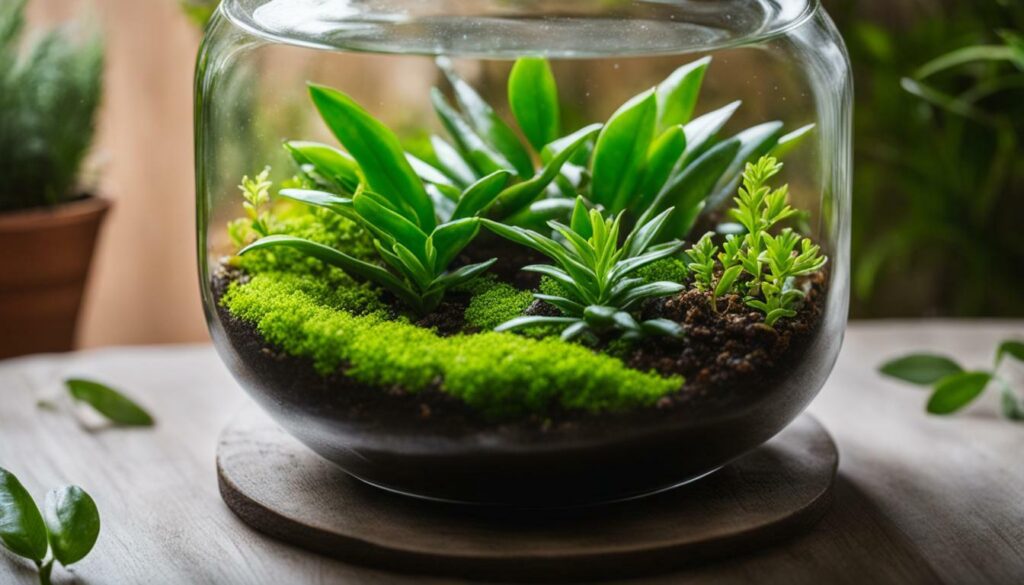
If you’re looking to add some variety to your terrarium, there are different ZZ plant options to consider. From the striking Raven ZZ plant to the compact Zamicro, we’ll introduce you to some exciting varieties and teach you how to propagate these plants for more greenery.
One popular variety is the Raven ZZ plant, which features stunning dark purple foliage. This unique coloration adds a touch of drama and elegance to any terrarium or indoor garden. The Raven ZZ plant is known for its ability to thrive in low light conditions, making it a perfect choice for those darker corners of your home. Its compact size also makes it suitable for smaller terrariums.
Another exciting ZZ plant variety is the Zamicro. As its name suggests, this dwarf cultivar is much smaller than the traditional ZZ plant, making it ideal for tiny terrariums or those looking to create a miniature garden. Despite its size, the Zamicro still boasts the same glossy, dark green leaves that are characteristic of ZZ plants. Its compact nature and low-maintenance requirements make it a popular choice among indoor gardeners.
Propagation Tip: To propagate ZZ plants, you can divide the rhizomes or take stem cuttings. When dividing, carefully remove the plant from its container and gently separate the rhizomes into smaller sections, ensuring each section has at least one stem and a few leaves. Plant these divisions in separate pots with well-drained soil. For stem cuttings, take a healthy stem and remove the lower leaves. Place the cutting in water or a well-drained potting mix until roots develop. Once established, these propagated ZZ plants can be added to your terrarium for even more greenery.
| Variety | Key Features |
|---|---|
| Raven ZZ Plant | Dark purple foliage, low-light tolerance |
| Zamicro | Dwarf size, glossy dark green leaves |
If you’re looking to expand your collection of ZZ plants or create new terrariums, consider adding these beautiful varieties. Their distinct characteristics and ease of propagation make them wonderful options for any indoor garden. Just remember to provide them with the appropriate care, including well-drained soil, suitable lighting, and regular watering.
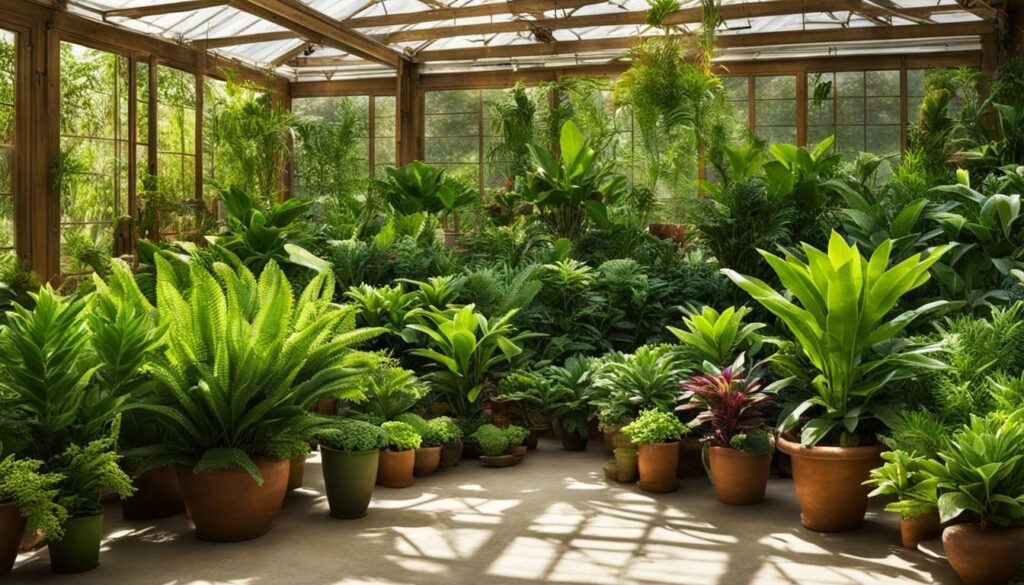
Air-Purifying Abilities and Safety Considerations
Beyond their aesthetic appeal and ease of care, ZZ plants offer the added bonus of improving air quality in your home. We’ll explore their air-purifying abilities while providing important safety considerations due to the plant’s toxicity.
ZZ plants are known for their ability to remove toxins from the air, making them excellent natural air purifiers. They can effectively filter pollutants such as formaldehyde, benzene, and xylene, which are commonly found in household products and can cause respiratory issues.
Safety is key when it comes to ZZ plants. While they are great additions to your indoor garden, it’s important to keep them out of reach of children and pets. All parts of the ZZ plant, including the leaves, stems, and roots, contain calcium oxalate crystals that can cause skin irritation and digestive discomfort if ingested. To ensure your loved ones stay safe, place your ZZ plants in areas where they cannot be easily accessed, and always wash your hands after handling them.
| Air-Purifying Abilities of ZZ Plants | Safety Considerations |
|---|---|
| Removes toxins such as formaldehyde, benzene, and xylene from the air | All parts of the plant, including leaves, stems, and roots, contain calcium oxalate crystals |
| Improves indoor air quality, reducing respiratory issues | Can cause skin irritation and digestive discomfort if ingested |
| Filters harmful pollutants commonly found in household products | Keep ZZ plants out of reach of children and pets |
Despite the toxicity of ZZ plants, their air-purifying abilities and low maintenance needs make them a popular choice for indoor gardening and plant decor. By following proper safety precautions and keeping them in areas inaccessible to children and pets, you can enjoy the benefits of cleaner air while creating a beautiful green sanctuary in your home.
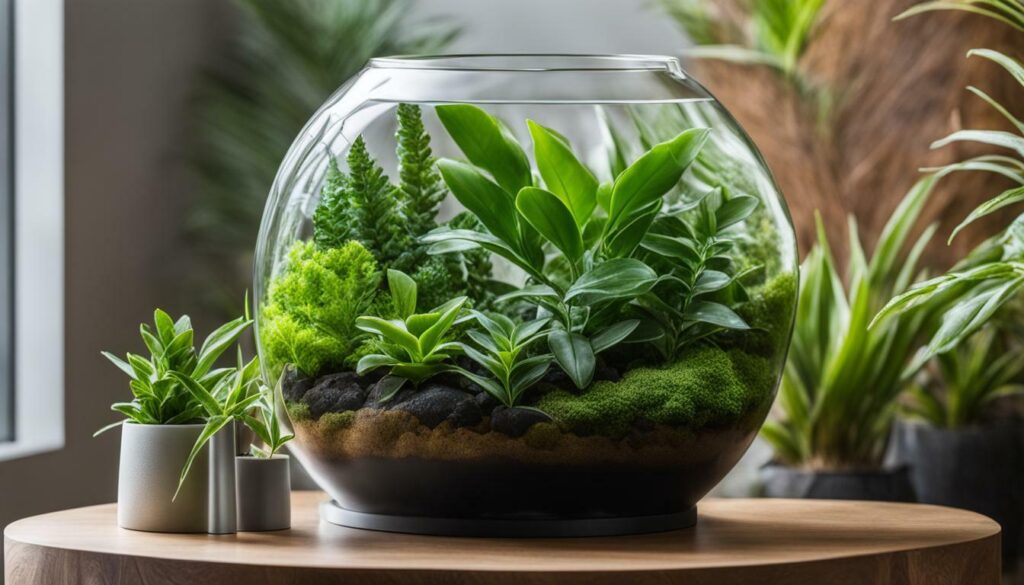 Even the most well-cared-for ZZ plants may encounter some obstacles along the way. In this section, we’ll troubleshoot common issues you may face and provide practical advice to ensure your plants remain healthy and vibrant.
Even the most well-cared-for ZZ plants may encounter some obstacles along the way. In this section, we’ll troubleshoot common issues you may face and provide practical advice to ensure your plants remain healthy and vibrant.Yellowing leaves: If your ZZ plant’s leaves are turning yellow, it is usually a sign of overwatering. ZZ plants are drought-tolerant and can withstand periods of dryness. To remedy this issue, reduce the frequency of watering and ensure that the soil is well-drained. Allow the top inch of soil to dry out before watering again.
Root rot: Overwatering can also lead to root rot, which can cause your ZZ plant’s roots to become mushy and slimy. To prevent root rot, make sure that the pot has drainage holes and avoid leaving excess water sitting in the saucer. If root rot is already present, remove the affected roots and repot the plant in fresh, well-drained soil.
Pest infestations: ZZ plants are generally resistant to pests, but they can occasionally attract mealybugs or spider mites. Look out for white cotton-like clusters or webbing on the leaves. To treat pest infestations, isolate the affected plant and wipe the leaves with a cloth soaked in mild soapy water. You can also use a neem oil solution to eliminate pests.
Stunted growth: If your ZZ plant is not growing as expected, it may be due to insufficient light. While ZZ plants can tolerate low light conditions, they thrive best in bright, indirect light. If possible, move your plant to a location where it can receive more sunlight. Alternatively, you can supplement the light with a fluorescent grow light.
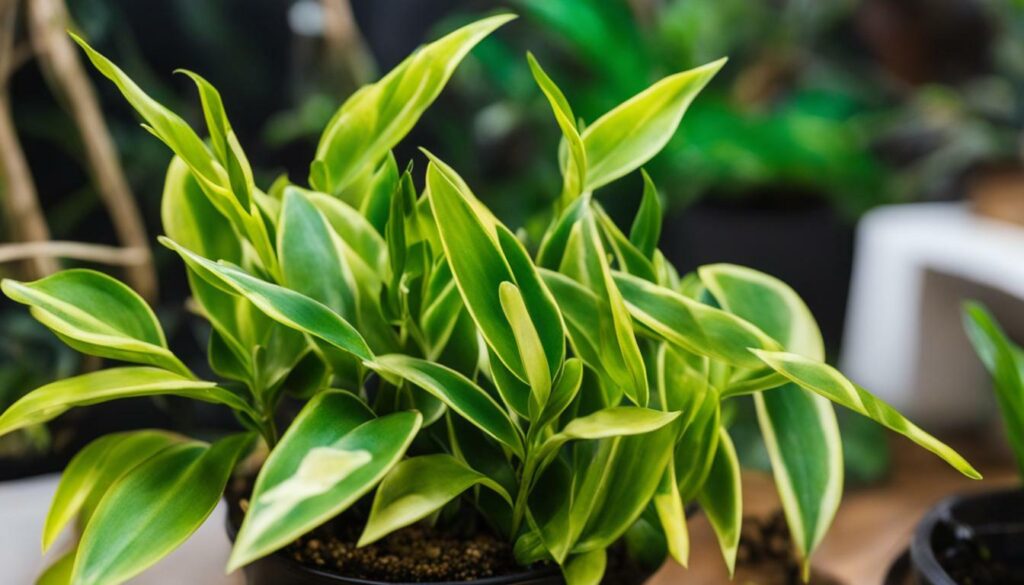
| Issue | Solution |
|---|---|
| Yellowing leaves | Reduce watering frequency and ensure well-drained soil. |
| Root rot | Remove affected roots and repot in fresh soil. |
| Pest infestations | Isolate plant and treat with mild soapy water or neem oil. |
| Stunted growth | Provide brighter, indirect light or supplement with grow lights. |
Quick Tips:
- Always allow the soil to dry out between waterings to prevent root rot.
- Inspect your ZZ plant regularly for signs of pest infestations and take action promptly.
- Consider fertilizing ZZ plants during the growing season to promote healthy growth.
- Trim any yellow or dead leaves to maintain the plant’s overall appearance.
“Taking care of ZZ plants is a breeze, but it’s important to address any issues promptly to keep your plants thriving.” – Jane Doe, Indoor Gardening Expert
Conclusion
Creating a lush terrarium filled with ZZ plants is a rewarding and enjoyable project for any indoor gardener. With their low-maintenance nature and ability to thrive in a variety of conditions, ZZ plants offer the perfect combination of beauty and functionality for your indoor greenery.
ZZ plants, also known as Zamioculcas zamiifolia, are native to Eastern Africa and are well-suited for beginners or those with a black thumb. Their glossy, oval-shaped, dark green leaves and bulbous rhizomes make them visually appealing, while their tolerance for low light and drought conditions make them easy to care for.
To ensure the health of your ZZ plants, they should be planted in well-drained soil and placed in an area with natural or fluorescent light. These plants can tolerate low humidity and irregular watering, but overwatering should be avoided to prevent root rot. Fertilizing ZZ plants a few times a year with a regular houseplant fertilizer can enhance their growth.
There are different varieties of ZZ plants available, such as the Raven ZZ plant with its eye-catching dark purple foliage and the dwarf variety called Zamicro. Propagating ZZ plants through division or stem cuttings is also possible, allowing you to expand your collection and share the beauty of these plants with others.
One important consideration when growing ZZ plants is their toxic nature. While they have air-purifying qualities and can remove toxins from the air, all parts of the plant are toxic and should be kept out of reach of children and pets. With proper safety precautions, ZZ plants can be enjoyed for their aesthetic appeal and air-cleansing benefits.
In conclusion, ZZ plants are versatile and resilient, making them excellent choices for terrariums and indoor gardens. Their low-maintenance requirements and ability to adapt to different conditions make them suitable for both experienced gardeners and beginners. Whether you’re looking to add a touch of green to your home or create a vibrant indoor oasis, ZZ plants are a fantastic option to consider.
Can the Care Guide for ZZ Plants also be applied to Spider Plants in a terrarium?
Yes, the care guide for ZZ plants can generally be applied to growing spider plants in a terrarium. Both plants thrive in low light conditions and prefer well-draining soil. However, spider plants may require more frequent watering to maintain the humidity level in a terrarium.
FAQ
Are ZZ plants suitable for beginners or those with a black thumb?
Yes, ZZ plants are low-maintenance and perfect for beginners or those with a black thumb.
Where are ZZ plants native to?
ZZ plants are native to Eastern Africa.
Can ZZ plants tolerate low light and drought conditions?
Yes, ZZ plants can tolerate low light and drought conditions.
How should ZZ plants be cared for?
ZZ plants should be planted in well-drained soil and placed in an area with natural or fluorescent light. They can tolerate low humidity and irregular watering.
What are the different varieties of ZZ plants?
There are different varieties of ZZ plants, including the Raven ZZ plant with dark purple foliage and the dwarf variety called Zamicro.
How can ZZ plants be propagated?
ZZ plants can be propagated by division or stem cuttings.
Do ZZ plants have air-purifying qualities?
Yes, ZZ plants are known for their air-purifying qualities and can remove toxins from the air.
Are ZZ plants toxic?
Yes, all parts of the ZZ plant are toxic and should be kept out of reach of children and pets.
What are common issues when caring for ZZ plants?
Common issues when caring for ZZ plants include yellowing leaves, root rot, and pest infestations.

